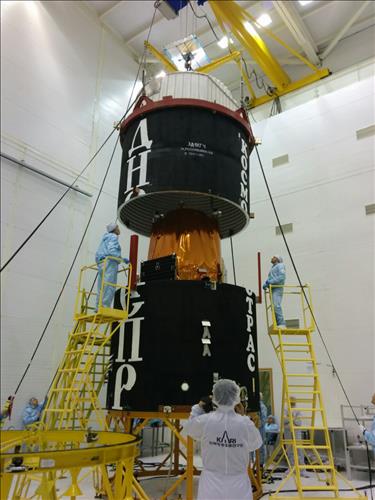- California Assembly OKs highest minimum wage in nation
- S. Korea unveils first graphic cigarette warnings
- US joins with South Korea, Japan in bid to deter North Korea
- LPGA golfer Chun In-gee finally back in action
- S. Korea won’t be top seed in final World Cup qualification round
- US men’s soccer misses 2nd straight Olympics
- US back on track in qualifying with 4-0 win over Guatemala
- High-intensity workout injuries spawn cottage industry
- CDC expands range of Zika mosquitoes into parts of Northeast
- Who knew? ‘The Walking Dead’ is helping families connect
S. Korea successfully deploys new science satellite

Russian space rocket Dnepr carrying South Korea’s new multipurpose satellite KOMSAT-3A is launched from Russia’s Yasny launch base on March 26, 2015. (Photo courtesy of KARI)
YASNY, Russia, March 26 (Joint Press Corps-Yonhap) — South Korea said Thursday it has successfully sent a new science satellite into space, its radio communication with the country’s ground station indicating that the satellite is operating properly.
The Korea Multipurpose Satellite-3A (KOMSAT-3A) was launched at 3:08 a.m. (7:08 a.m. KST) from the Yasny launch base, located some 1,800 kilometers southeast of Moscow.
A radio communication between the satellite and South Korea’s ground station was established at 1:05 p.m. KST, or 5 hours and 57 minutes after its launch, according to officials from the Korea Aerospace Research Institute (KARI).
“We may conclude that the launch and deployment of the KOMSAT-3 have been successful following its successful communication with the country’s ground station in Daejeon,” Choi Seok-won, a KARI official in charge of the satellite program, said.
Beacon signals from the 1,100-kilogram satellite were earlier picked up by Norway’s Troll Satellite Station, then again by Svalbard Satellite Station in Norway, indicating the satellite has reached its target orbit.

South Korea’s new multipurpose satellite KOMSAT-3A is being encased before it is loaded onto Russian space rocket Dnepr before its launch at the Yasny launch base in Russia on March 26, 2015. (Photo courtesey of KARI)
The KOMSAT-3A was sent into space on a Russian rocket, Dnepr, a launch vehicle converted from a Soviet-era intercontinental ballistic missile.
Real-time observation of the launch was unavailable as the Russian launch pad remains off-limits to public access.
The science satellite is designed to complement South Korea’s three other multipurpose science satellites that are currently operational.
The KOMSAT-3A is equipped with an optical lens with the highest resolution so far on any South Korean satellite that can provide clear images of any object greater than 0.5 meter in diameter on the Earth’s surface.
It is also equipped with an infrared sensor that can detect changes in temperature, enabling it to monitor any volcanic movements or forest fires.
Together with the KOMSAT-5, the country’s first science satellite with synthetic aperture radar launched in August 2013, the new satellite will help enable 24-hour monitoring of the Earth’s surface regardless of weather conditions, KARI officials said.
The KOMSAT-3A will circle the Earth approximately 15 times a day in a synchronous orbit for the next four years.
South Korea is planning to develop its own space launch vehicle for a test launch in 2019.















